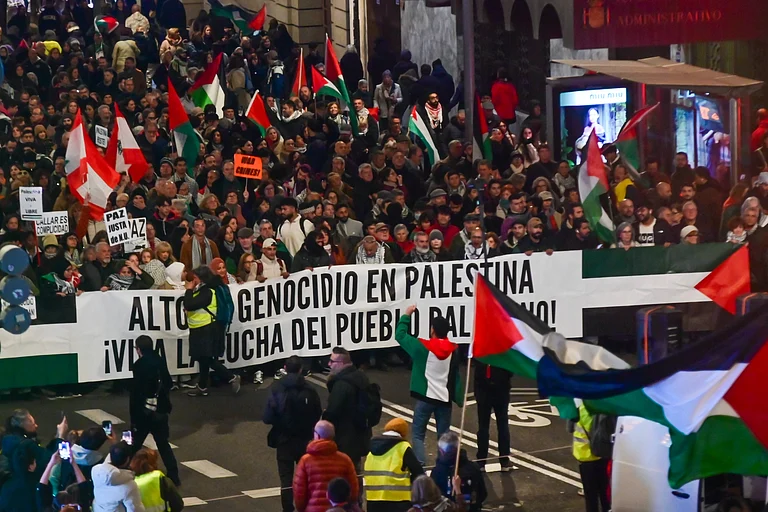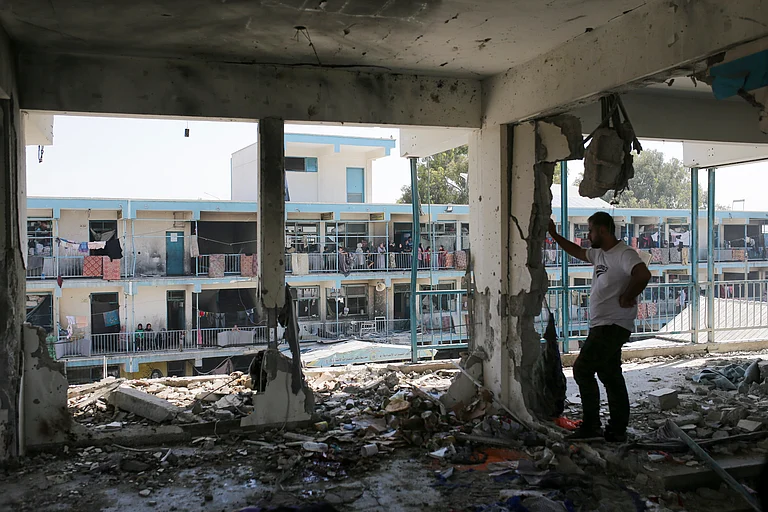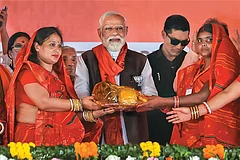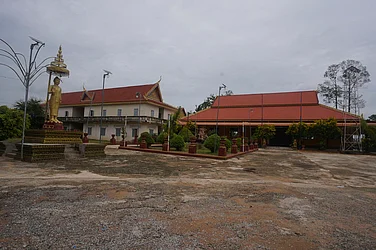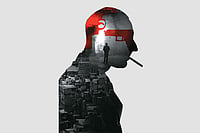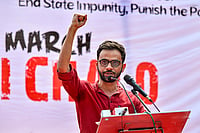
There are no soldiers marching to victory. Except those in Gaza, who have prevented the Israelis from annexing their territory.
The Palestinian refugee camps in Sabra and Shatila still bear the scars of the 1982 massacre that took place under the auspices of the Israeli occupation.
Their homes in the Galilee have faded away, but the desire to be in Palestine remains strong even though they are the fourth generation of refugees.

Lebanon woke up to the sound of gunfire, the start of a civil war that lasted till 1990.
Bullet holes in the walls of a Beirut street mean nothing. You would need an archaeologist to tell you when they were made, or a forensic expert—if there are any bullets left on the walls—to tell you who fired them. Henry Loussian of Henry’s Handmade, a jewellery shop in Hamra, gathers up old bullets and makes them into jewellery. Bullets take life and create enduring grief. Sensitive artists like Loussian transform them into something beautiful that brings pleasure and joy. Up above Beirut in Koubba in Batroun, Loussian has taken over an old house and is recreating it with the detritus of houses being demolished to build steel and glass towers for Saudi princes and Lebanese bankers. Alchemists like Loussian turn bullets into flowers.
Fifty years ago, in 1975, Lebanon woke up to the sound of gunfire, the start of a civil war that lasted till 1990. A decade ago, I interviewed a former director of Lebanon’s Internal Security Forces, Omar Makhzoumi, who laughed when I told him that the civil war had ended in 1990. “No,” he said, “the Civil War is in half time.” Israel invaded Lebanon in 1982 and remained in the country till 2000. The Syrian Army, meanwhile, entered Lebanon in 1976 as part of the civil war and remained in the country till 2005. The very next year, in 2006, Israel launched an all-out war against Lebanon, trying to decapitate Hezbollah—the paramilitary Lebanese organisation which had been responsible for ejecting Israel in 2000. It is specious to list the numbers of dead and the vast destruction of the infrastructure—since all numbers pale before the genocide in Gaza. But, as I experienced in 2007, Lebanon looked like it had been hit by an atomic bomb and the population felt utterly shaken. There were new bullet holes in the walls, sometimes near the old bullet holes. Bullets for Loussian to collect and fashion into hammers and sickles as well as into images of the Egyptian singer Umm Kulthum (1898-1975). Wallahi Zaman, Ya Silahi (It’s Been a Long Time, O Weapon of Mine), Umm Kulthum’s great song of Arab nationalism, buzzes out of an old café that has pictures of Gamal Abdul Nasser and salutes an age gone by:
The nation creeps like light.
The people are mountains and seas,
a volcano of anger,
a boiling one, a quake digging graves.
These words sound empty to me. Lebanon has no real sovereignty. In 2020, the port of Beirut exploded, and then when this genocide began, Israel started its bombing of the country, including with a mega-bomb to kill Sayyed Hassan Nasrallah (1960-2024), the leader of Hezbollah. There are Israeli drones overhead, and Israel regularly bombs southern Lebanon and flattens civilian homes in preparation for an expansion of Israeli territory. No wonder there is a sense that violence is endemic to Beirut and that the current Israeli destruction of the villages and towns in southern Lebanon is natural. Because of course it is, and it is not.
Listening to Umm Kulthum sing about the glories of Arab nationalism is painful. There is so little of it on display. As Israel continues its genocidal violence against the Palestinians, neighbouring Arab countries seem almost paralysed. Lebanon’s government—under pressure from the US and France—wants to disarm Hezbollah, the only military force able to try and defend the country’s sovereignty. Egypt opened the door to normalisation with Israel in 1979, and now does nothing to force open the Rafah Crossing, send aid to Gaza, and allow seriously ill Palestinians to enter Egypt to be treated in its hospitals. Egypt’s leader, President Abdel Fattah El-Sisi, has not once threatened to put his over two hundred F-16 Fighting Falcons in the air to enforce a no-fly zone over Gaza. On the other side, the Queen of Jordan, Rania al-Abdullah, was forthright in two interviews with CNN’s Christiane Amanpour in 2023 and 2024 about the Israeli violence and the ‘glaring double standard’ of the West in failing to condemn Israel’s attack on civilians whilst it was so vocal against Russia. But Queen Rania’s statements did nothing to move her husband, King Abdullah bin Hussein, who sat on Jordan’s 1994 peace deal with Israel and never threatened to withdraw from it because of what his wife called ‘the depth of the grief, the pain, and the shock that we are feeling here in Jordan’. Jordan’s fleet of F-16 Block 70 sat in its hangar, the tarpaulin barely moved on behalf of the Palestinians. The ugliest display of the collapse of Arab nationalism comes from Syria, where it was Israeli air cover that allowed the former al-Qaeda chief Ahmad al-Sharaa to capture Damascus, while Israeli tanks rolled into the former United Nations buffer zone outside the occupied Golan Heights. Israel has more than doubled its seizure of Syrian territory. Al-Sharaa, a creature of the Israelis, has neither condemned this expansion of Israel into Syria nor made any gesture regarding the genocide. These are key countries in the Arab League, which has been relatively quiet throughout the past few years. Umm Kulthum sounds utterly foreign in Amman, Beirut, Cairo, and Damascus.
It has been a long time for the soldiers.
Advancing with a thunderous roar.
Swearing never to return,
except with an epoch-making victory.
There are no soldiers marching to victory. Except those in Gaza, who have prevented the Israelis from annexing their territory. But those Palestinians are alone in their bravery.
The Palestinian refugee camps in Sabra and Shatila still bear the scars of the 1982 massacre that took place under the auspices of the Israeli occupation. I have been here several times, the last time with the great Irish journalist Robert Fisk (1946-2020) who had been one of the first journalists into the camps during the massacre. Fisk had walked me around and showed me what had happened. This time there is no Fisk. But I am here with a few local leaders of the Palestinian community. They are telling me about their own feelings of despair at the violence in Gaza, but at the same time of their sense of pride in the resistance of the young fighters. The Shatila camp was established in 1949 by the United Nations for the Palestinians who had been wrenched out of their lives by the new Israeli military from their homes in the northern Galilee. I ask them where their families are from and they say, al-Birwa—the birthplace of the poet Mahmoud Darwish (1941-2008); Saffuriya, the legendary birthplace of Mary, the mother of Jesus—and bombed by Israeli aircraft on July 1, 1948; Balad al-Sheikh, the site of a massacre on December 31, 1947; and Kafr Lam, near Haifa, bombed by the Israeli Navy in 1948 to ‘depopulate’ the village. These villages dot Galilee, which still has about 750,000 Palestinians but now without land; in 1976, the Israelis seized most of their land, resulting in a massive protest campaign by the Palestinians on March 30, which is now commemorated as Land Day. Over the past seven and a half decades, the Palestinians in Sabra have not been able to feel that they would be able to return home. Their homes in the Galilee have faded away, but the desire to be in Palestine remains strong even though they are the fourth generation of refugees.
Young Palestinians bristle with anger at the genocide. But that anger comes with paralysis. They feel that they cannot do anything. The Land Day protest in 1976 included the mayor of Nazareth, Tawfiq Zayyad (1932-1994), a communist poet and revolutionary, whose poem Huna Baqun (Here We Stay), inspired them. A few lines from the poem are painted on a wall in Sabra:
We get hungry, get naked, and defy: chant poetry.
Fill the angry streets with protests and fill the prison with dignity.
And make children, a revolutionary generation, after generation.
That last line is powerful. Generation after generation. Elders who came in 1948 and their children then saw two generations after them born in the camp in Sabra. The massacres of 1948 chased them to the camp in 1982, and now on their phones they watch the fires in Gaza. ‘We are waiting to go home,’ says a young woman, Bushra, who must be no more than 25. For her, home is Ayn al-Zaytun, the site of the massacre of Palestinian males between the age of 10 and 50 in 1948 (the village became the fictional setting for Elias Khoury’s tremendous novel, Bab al Shams or Gate of the Sun, 1998). Bushra has never been to Ayn al-Zaytun, or to the Galilee. The furthest she has been from her home is to Saida along the Lebanese coast to the other Palestinians camp of Ain al-Hilweh to meet relatives.
I often think of my own relatives who left Lahore in 1947 and came by truck to the new Indian republic. At that time, both India and Pakistan respected the partition ‘award’ from the British, with neither trying to invade and occupy the other. In Palestine, however, Israel rejected the partition and seized almost all the territory, expelling the Palestinians into refugee camps outside Palestine or in narrow strips such as in Gaza or the West Bank. Imagine if this had happened between India and Pakistan, and if one of the countries had seized the land of the other and made their new citizens into permanent refugees. I think of my relatives in the transit camp of Gurdaspur, still there, me born there, the great resentment built up, and then punctual bombardment of our homes despite our displacement. How would we feel then?
I am in Beirut during Prime Minister Narendra Modi’s birthday (September 17). On X, Israeli Prime Minister Benjamin Netanyahu greets him, and Modi responds. On that day, Israel killed 61 Palestinians in Gaza City. A month later, it is Netanyahu’s birthday. Modi greets him. “We are waiting to go home,” says Bushra on a day that results in the death of dozens of young Palestinians such as herself in Gaza (the median age in Gaza is 19.5 years). Modi (born 1950) turned 75, Netanyahu (born 1949) 76. Netanyahu was born in Jaffa (Tel Aviv), a town where the new Israeli state removed 50,000 Palestinians to create the capital of the Jewish State. There is something unpleasant about these public greetings between Modi and Netanyahu, taking place to the sound of gunfire.
Adjacent to Sabra is the martyr’s graveyard. I stroll over to pay my respects to Ghassan Kanafani (1936-1972), one of the great Palestinian writers and revolutionaries. Burial grounds are a curiosity in a country where bodies had been tossed into the sea during the civil war, where bodies continue to be incinerated by high blast bombs, and where bodies get disappeared in mass graves. Kanafani, and his niece Lamis Nijem (eternally seventeen), had been killed by an Israeli bomb. Kanafani, like Bushra and the residents of Sabra, was from the Galilee, born in Acre (Akka). He was the voice of Palestine, a writer of stories (Men in the Sun, 1963) and editor of the al-Hadaf (The Goal), the newspaper of the Popular Front for the Liberation of Palestine. Kanafani’s writing humanised his people who had been demonised by Israeli propaganda and Western Orientalism. I want to place a rose on his grave, but I have brought nothing. Someone has left a bullet casing nearby.
(Views expressed are personal)
MORE FROM THIS ISSUE
Vijay Prashad is the director of Tricontinental: Institute For Social Research. his latest book is on Cuba: Reflections On 70 Years Of Revolution And Struggle, written with Noam Chomsky.
This story appeared as Bullet to an Amulet in Outlook’s November 11 issue, titled "Caste is the Biggest Political Party in Bihar," which explores how caste plays multiple interconnected roles in seat-sharing and coalition-building in the land of the setting sun.








